Post-Labor-Day Celebration: 05F-10
After a two-month layoff, I returned to the beach on the Saturday after Labor Day. Whew. It was good to be back. The report follows the images.
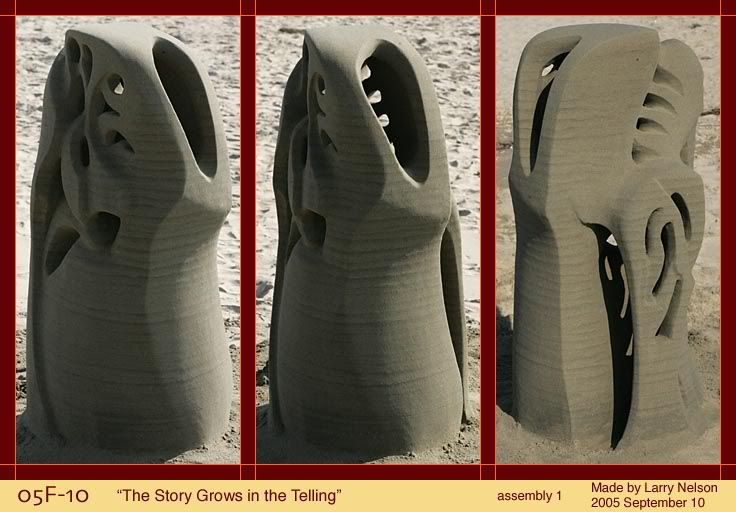
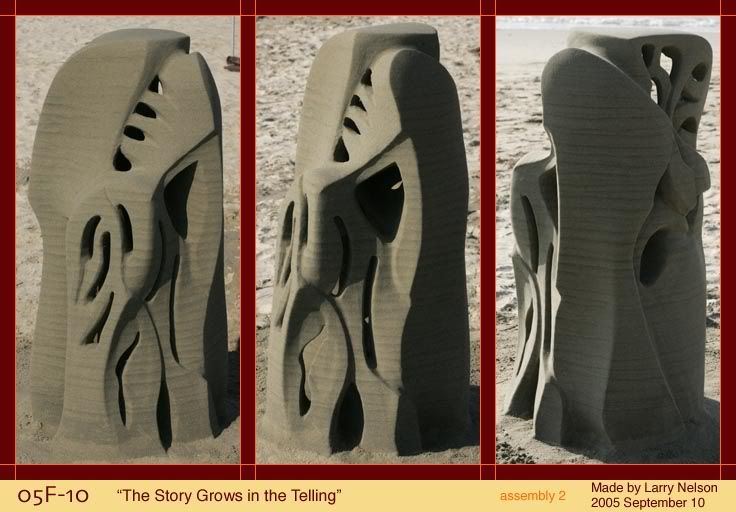

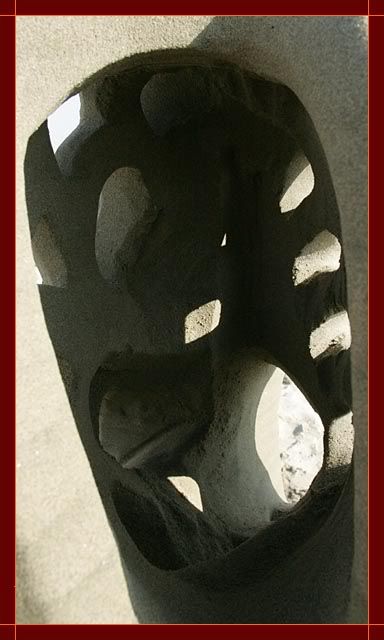
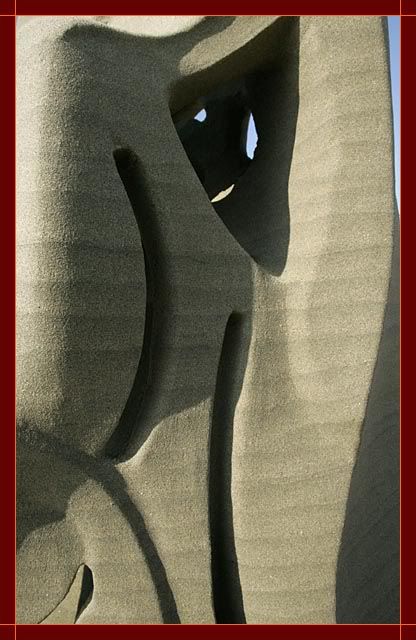
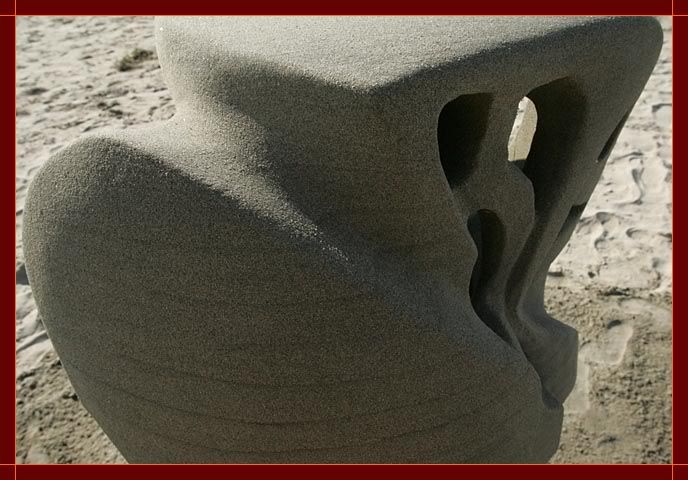
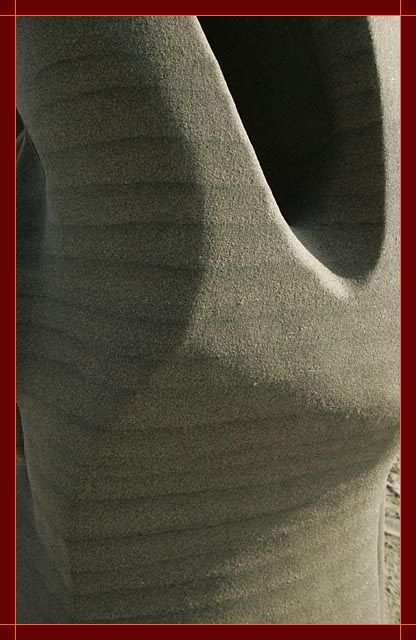
Grateful Return
Summer. Crowds. Heat, sunlight unloaded in wholesale lots onto skin designed for northern climes. July and August are interminable. I move sculptures to Fridays and walk carefully, quickly, on the hot dry sand. For two weeks July is cool, and then summer reasserts itself on the day I planned for the next sculpture. Add the sunlight to all the other loads I've been carrying around and the result is static. The day brightens and I watch it from indoors. Recycle the count for two weeks.
Saturday is cooler, and Sunday reasonable. The next two weeks are cool, and then sculpture day comes in blazing. This drives more people to the beach, and once more I close the door. After that stiction takes over. We're in August. Just sit it out.
This isn't the only time I've laid off. In the old days I skipped winter, thinking that sand sculpture was a summer activity. I learned that winter is actually the best time, even with the uncertainty of sand and weather. The light is low and soft, weather throws in irregular beauty, and the people I meet are much more relaxed. Even so, there just came times when I didn't sculpt. A month, two months, three months, equipment problems, spirit problems. How long after the last sculpture does a sand sculptor cease to be one?
Ideas, it seems, seep into awareness at a certain rate. Frequent sculpture uses ideas, perhaps faster than the well can replace them even while honing skills. Sculptures done after a hiatus are unpredictable: the idea well is full and the hardest aspect of making a sculpture is restraining their flow so that a whole sculpture results, rather than an assemblage of unrelated but enthusiastic parts.
Still, creativity will come out. You'd think that in a world whose only moveable objects are traffic cone simulacra, and the only control mechanism feet, that nothing could be done that could be called art, but desperation is a proven boost to crossing closed borders. I made a series of experiments in Until Uru and learned that, yes, it is possible to make something pretty. Add Great Zero markers (floating white bubbles) and you're just doubled the number of colors in your pallette. Richness is relative, and the location is calming: water laps against the blue stone of the Ferry Landing under the Great Arch, and unlike the beach there are few people around.
Well, most of the time. Post-migraine one evening, having taken the only cure I know of from two bottles of beer, I was very suggestible.
"Let's go to the City and see if we can find more cones," Jeruth said.
We did, and we did, and there were four of us whooping away down the Great Stairs herding cones before us. Downhill, ever downhill, all the way from Tokotah to the Ferry Landing because the Second Landing just wasn't big enough.
Artists always look crazy. What do you expect? There's only one way to get something done, and that's to concentrate. I'm used to this on the beach, and with my friend Rich there to run interference for me I do pretty well. He answers the questions, I sculpt. On the Ferry Landing there were several bemused people who'd never seen a driven sculptor in action. I have no clear idea of what they said to each other as I dealt with lag and other problems to make in cones what existed in my mind, other than one person said I was a hoot, and some were dancing. I could see the text chat scrolling but paid it no attention except a few times when I, perhaps subliminally, became aware that they were talking about me. Unfair, I thought. Shooting fish in a barrel. I really hope no one was keeping a chatlog to use for blackmail in a few years. In a land without baseball and TV, perhaps cone-wrangling will become the premier spectator sport.
Eventually I got the design done. For some reason I was having a hard time modelling the design in my mind. Something about it just wouldn't come together, perhaps based on general resistance to copying someone else's designs. And, in another unusual aspect, I asked for help. Tehl had to set the markers for the logo's linking panel. Then I had to use Jeruth as a surveying instrument because I couldn't see the markers.
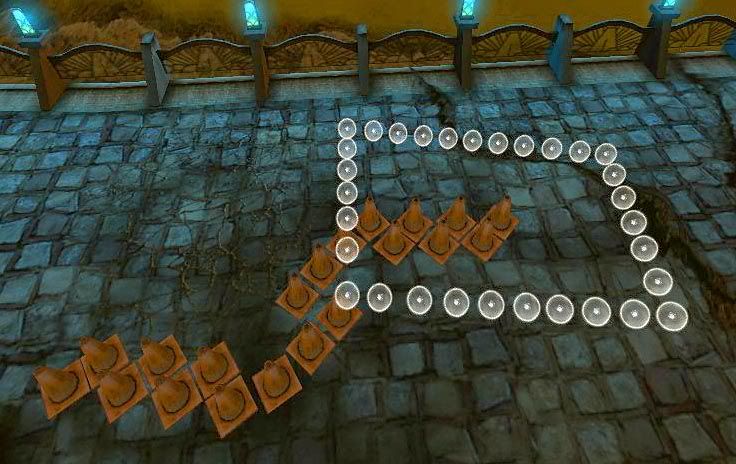
The result was popular, but something about it wasn't right. Still couldn't figure out what. I wandered off to bed somewhat dizzily, it being much later than I thought. Doesn't matter whether it's cones or sand. Time just disappears.
And eventually enough of it disappeared to put me on the good side of Labor Day. I went to the garage to check equipment.
Build number: 05F-10 (lifetime start #308) filtered low tide sand
Title: "The Story Grows in the Telling"
Date: September 10
Location: Venice Breakwater, on the flat
Start: 0730; construction time approx 8.75 hours
Height: 3.4 feet (Latchform); sokkel height about 6 inches
Base: 1.75 feet nominal diameter
Assistant: none
Photo digital: EOS-1D walkaround and wide-angle details
Photo 35mm: none
Photo 6X7: none
Photo volunteer: Rich, with Canon SD520 process and completion
Video: none
Equipment note: none
1. A Slight Problem of Air Retention
Two months. I pull the trailer out of the garage to see if everything is still there. The only thing missing is air in the left tire. Hmmm. I pump it back up and it seems OK, so I push the whole load back into the garage and close the door.
Start time is dictated by the tide. In the morning light I hook up the trailer and then notice that trapped air has a desire to be free that's stronger than my desire for an early start. Time loss, molecular persuasion assisted by the long-distance bicyclist's best friend and skill attained in the use thereof. A quick patch and I'm on my way.
2. A Slight Problem of Water Retention
The morning is cool, dim, overcast. Unlike Fridays, Saturday mornings are calm. No commuters, just paper deliverers and the joggers on the Boardwalk that hasn't seen boards ever.
Tides and surf have nicely rounded the isthmus behind the Breakwater. Choosing a sculpture site is made difficult by having forgotten to look at the tide chart: where will the afternoon high hit? One result of the long hiatus is being out of synch with the tide. Make a guess, start the sculpture, build the base higher and wider in case I miss.
It gets higher yet when, in an attempt to force the long-idle form's oval plan into something more like its usual circle, I nudge it one time too many and the water inside rushes out unstoppably. What an affront. This never happens to me.
I start over and make the same mistake. Two blowouts in one start. Something of a record. Finally a few brain cells start working together and I figure out how to do this. The form is stiff plastic, and takes a set in whatever shape it stays in, in this case being stored horizontally on the trailer. I throw some sand in, nudge it into place to hold the circular plan, then put in more sand to seal the rest of the periphery. This time it holds water.
September sand. The shells of spring are gone and the fine sand lies in a thick, easy-to-dig bed. Filter, tamp, add water, filter, tamp, go get another load of sand, fetch more water, repeat for two hours.
3. The Hard Part
The form pops open, springing free, leaving the damp dark column of sand standing alone. It always seems like a miracle, these vertical, slender cylinders. Some have told me that it's perfect as is. Cylinders are nice, but I think I can do better.
The problem is choosing which better. Wayne, my boss, said one day when he had to call my name a couple of times to get my attention, "He's thinking about sand." Work with someone for 13 years they get a pretty good idea, if only by osmosis, of what's happening inside another. In this case, I was building models in my mind.
What starts isn't what finishes. I make the major cuts in accordance with the day's arch-springing-from-face idea, but after that the divergences accumulate. A cut here, a hollow there, fingers seeking perfection or something imponderable, and the sculpture grows into something inconceivable. It can only be made, not planned, guided by experience and desire.
Ideas love company. When they're invited to come in, they bring their friends and it's party time, no matter what the host desired or designed. It's a fascinating balancing act, keeping them from tearing the house down while encouraging freedom for surprises. I started writing a story that would describe in about 5000 words the events of a fictional character's doings over about 10 years of his life, but the story has so far covered about two months, and runs about 35,000 words. Sand sculpture is limited by daylight. Ideas become impatient for their time in the sun, but the story still grows in the telling.
A large group of people in bright yellow T-shirts comes along, picking up trash. They stop to chat. One asks if he can try sculpting.
"No, but I'll show you how. Come with me. You others, keep an eye on this and don't let anyone touch it."
I demonstrate free-piling for two people unwilling to get their hands dirty. Well, maybe he'll remember. They amble off to the next short-attention-span event.
The sculpture begins to cook. It's taking on a shape that's unusual, and interesting. It even includes places large enough to dig and remove internal sand. I hollow out the topmost part and cut some small holes that connect with it.
4. Contrast
I used to balance hollow against sand and hope that it would hold up. Any sculpture still standing at the end of the day was a success.
Once success is assured, where do you go? Keep repeating the same thing and become a hack, like musicians constrained by fame to trademark riffs and painters who keep doing the same painting with different subjects? I have my own problems with short attention span: an idea conquered is one behind me. I need to go farther up, farther in, to swipe a phrase from C.S. Lewis. It's no fun to stay with certainty in design, but it's very hard to stage a revolution every time out.
Design, however, is complex. The field is wide and there's a lot of room for failure. Even sculptures that stood the test of construction could fail in the day's-end artistic critique. Successes became rare as my standards changed from simple existence to some kind of beauty I could feel but not touch, but when they came they resonated so strongly I could have shattered right there on the beach.
How do your produce tension in a medium that is completely intolerant of anything but simple compression? You play with shadow, detail, light, reflection, and try to balance them with surprises hidden here and there. Walk a step around the sculpture, it should call you on to another step, and another, getting you lost in a world you thought impossible. Ideally, it would keep calling you around until some time later you realized you've done six circumambulations and still haven't figured it out.
A sculpture that's all air wouldn't be very interesting. Ditto the solid cylinder. Surprises come out in the making, in the relationship of part and space, in little strokes that lead to big ones and in how one surprise relates to another. It can't be planned. At least, by me.
I used to hide the contrast inside. The outside would be strong and smooth, and inside you'd see these little openings lit up by the sunset. Then I started putting them on the outside, balanced by nearby slabs devoid of anything but the sand's natural detail. You could see the design demarcations. This area is for complexity, this for balance, each placed for effect.
This sculpture's big change is in integration. No longer are there separate zones for microsculpture and bigger elements; they sort of fade into each other, wrap around each other, changing shape as various elements take off on their own or come back together. I may not be paying much attention to God, but he's still paying attention to me. Faithful to the unfaithful, doing exactly what he promised to do, and sticking with it because he is truly committed to doing what is right whether I enjoy it or not.
On the southeast is a big problem: that default backward 7 shape that is so easy to end up with by wrapping a curve around a cylinder. I'm sick of it but have no idea what to do about it; I've failed repeatedly in this.
When in doubt, carve. I start from the bottom of a curve in the microsculpture above and continue it down through the top of the 7, and parallel that with another extension. The detail work is hard but the result is a woven look that may be the sculpture's most delightful design. A year ago it would have been impossible. I didn't have the skill. It sits atop a broadly curving base that doesn't look like something left there because I couldn't figure out what else to do with it, but like part of the sculpture. Its solidity contrasts with and balances the airiness above.
Just don't quit. That's all God has been asking of me lately. Don't let go. Works for sculpture, too. Don't accept the easy way out.
"Mommy, why is he wearing a skirt?"
"Because it's comfortable," I say.
"Are you a girl or a boy?"
I laugh. "I'm a boy."
The afternoon goes on, warming, then cooling. People come and go. It's nice to be back here. The clouds have dissipated, but instead of August's rage we get September's tempered sunlight with a cool breeze. A few pelicans cruise by, high and businesslike. Another bird, shaped like a sandpiper but bigger and dark brown, runs back and forth. Sets of big waves bash the breakwater, delighting tourists and surfers each for different reasons.
5. Clean-up
"Well, Rich, that's it."
"Finished so early?"
"Oh, there's a lot of clean-up to do."
Over an hour later he says "You were right."
"Yes. But I'm almost there now."
Another fifteen minutes and I call it good. As with any sculpture with this many tiny elements, true clean-up is impossible. It's always a compromise. Perfect clean-up and detail control would take days of fussy work and I'm not here for that. Nor is the sun going to allow it. Instead of perfection, I work for good enough. The core idea here is to allow the sculpture to present itself whole, without distractions. Some people come along and seek out the tiny imperfections that any hand-made, human-limited object has. I've learned to overlook these, to seek the intent and shape, and to reduce the imperfections through clean-up to just below my level of perception. It's one of the best things about sand sculpture, this enforced limit on fussiness.
After cleaning up the sculpture, I landscape the base. This helps the sculpture look its best, the built-up sokkel both lifting the sculpture above the common sand and protecting it from mistakes in predicting the tide. It came close this time, close enough to send me over to the lifeguard tower to check the tide height and time, but ultimately left the base untouched.
Then I gather some sand, laboriously, stupidly, handful by handful until there's enough to make a signature pad. As I start putting equipment away I hear a man who has been watching for a time ask Rich, "That's the signature?"
Early start, early completion. The light is far from flattering, but one thing my big, heavy camera does well is deal with harsh light.
First, it needs a way to hold the images. Its memory card is quite safely located on top of the computer monitor at home. Fortunately I have the little camera too, and it uses the same kind of card.
Strong light, deep shade. Dynamic range made for black-and-white film, or a digital camera with a big sensor. My own dynamic range, however, is lacking, and I look stupidly at the camera and try to figure out how to set some exposure compensation for the shadowed side. The indicator doesn't move as I randomly turn the dial. I give it up and go back to photographing. The wide lens gets the details, with the front element only a few inches from the sculpture.
6. Ending the Day with Music
I load my equipment back onto the trailer, whose left tire still has the air it started with. Of such small things is importance made at this stage.
We take one last turn around the sculpture.
"It's a good one," Rich says.
"Yes. I like it." This is fairly rare, but more common this year. What's unusual with this piece is how it looks like a whole. All the parts work together, flowing into one another while being distinct. It's one of the bell-ringers that chimes in my mind long after I turn my back and start walking away.
Rich and I drag the load across summer-dried sand, between kite flyers and sunbathers, to where my bike is locked. Step by step I get everything together, loaded and strapped into place, and then go looking for the key to the lock. It's inside the pack, which is inside the form, under the other stuff. Tiredly I dig it out, unlock the bike and throw a tired leg over the frame.
"Thank you, Rich. I'll keep you posted, but the next one should be in two weeks."
"OK. Fare you well."
"Good night."
I wobble off northward. On my way up the little hill, eastbound on Rose, a woman calls from the porch of an apartment, "Nice kilt!"
"Thank you." I didn't think it was very noticeable when riding a bike. Well, it certainly doesn't look like shorts. It's a nice little smiley boost up the hill to the traffic signal.
I get home without being an accident statistic. Pure fatigue. At least I'm not starving. I had sandwiches and other things which got me through the day better than the usual Force Primeval bars and peanuts. There are other criteria for judging food than just how well it holds up underneath the camera gear.
A quick snack, start the computer, basic clean-up, get the music going, enter the Until Uru neighborhood and then park my avatar while I shower off all the sand. By the time I get back there are many comments on the screen:
"Where are you?"
"Are you there?"
Poke, poke.
"Well, when you get around to it..."
"All right, all right, I'm here now. Didn't want to get sand on the keyboard."
"Good idea. And now I know where you are. I'm coming," Jeruth says.
I get the ballads playlist going and soon Jeruth links in. Music Night. A tradition I started in mid-June that has grown to something important for several of us. Music and conversation.
My conversation is, um, interesting. It's not so much a question of typos, as figuring out where typos end and real text begins.
"No problem," Jeruth says. "I speak Ktahdn."
And she does. Experience has taught her how to interpret my mistakes. Perhaps that has more general applicability to life.
A few others join us. I switch to the dance playlist and we get active, fingers flying on keyboards all across the United States. There's even one from England. Music night has run until midnight, but my sculptor's euphoria runs out long before that. I play the closing song and say my good-byes before the typos get any worse, stagger to the bedroom and lay my stiff body down.
7. Guiding Imagery
Of course, this having been a good sculpture, ideas pop off in my mind like fireworks. This make sleep difficult. I just sort of watch the show, and then a few thoughts finally come together.
Yeow. I know what I did wrong with the camera. The exposure compensation scale is inside the viewfinder, and the one on top is for something else. Who knows where the compensation ended up. The images could be alll dark! I was rusty in more than just setting up the form. Regular practice is the only way to stay together when you don't read manuals. Well, we'll deal with that when it comes. and fortunately Rich shot his own round so he can save me. Again.
The next morning I foggily traipse over to the computer and transfer the images. I'm a lucky man. My random dial-twiddling left it in a useable place. Not good, but useable with some heavy-handed adjustments in Photoshop. I make the image assemblies, and am once again grateful for having been able to buy this camera.
Then it's time to consider another failure. That Guild of Greeters logo still bothers me. Tehl placed the makers perfectly but the cones aren't right. I load the Web site, study the logo and begin to see where I went wrong. A few sketches fix the design. I know what I need to do.
First, I need more cones. I link in and herd every cone I can find down to the Ferry Landing. After taking apart most of the existing design, I carefully replace the cones. There are just enough to complete the basic logo. It's much better. I call it good and shoot some images. To do better will require administrative help in acquiring more cones.
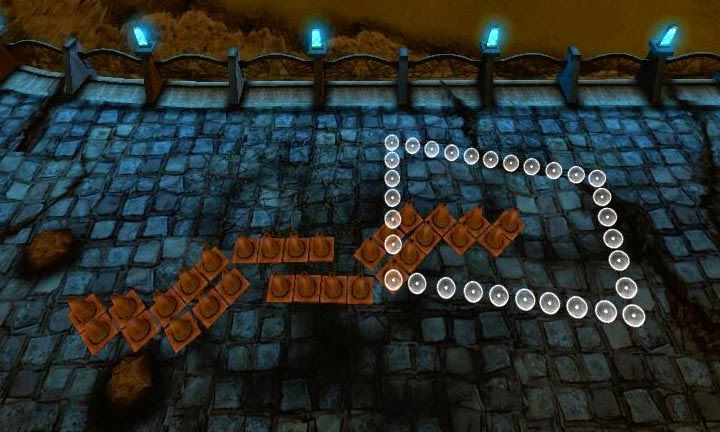
The rest of the day fades away into post-sculptural fog. This time the fog sort of glows. It was very nice to do a sculpture, to be creative in the truest way I know. I think in images. Words are a second-level abstraction. Truth is in the sculpture.
2005 September 11
Rewritten September 13
Image of first Guild of Greeters logo by Tehl Nava. I modified it to include a cone that was there but invisible from above.







Grateful Return
Summer. Crowds. Heat, sunlight unloaded in wholesale lots onto skin designed for northern climes. July and August are interminable. I move sculptures to Fridays and walk carefully, quickly, on the hot dry sand. For two weeks July is cool, and then summer reasserts itself on the day I planned for the next sculpture. Add the sunlight to all the other loads I've been carrying around and the result is static. The day brightens and I watch it from indoors. Recycle the count for two weeks.
Saturday is cooler, and Sunday reasonable. The next two weeks are cool, and then sculpture day comes in blazing. This drives more people to the beach, and once more I close the door. After that stiction takes over. We're in August. Just sit it out.
This isn't the only time I've laid off. In the old days I skipped winter, thinking that sand sculpture was a summer activity. I learned that winter is actually the best time, even with the uncertainty of sand and weather. The light is low and soft, weather throws in irregular beauty, and the people I meet are much more relaxed. Even so, there just came times when I didn't sculpt. A month, two months, three months, equipment problems, spirit problems. How long after the last sculpture does a sand sculptor cease to be one?
Ideas, it seems, seep into awareness at a certain rate. Frequent sculpture uses ideas, perhaps faster than the well can replace them even while honing skills. Sculptures done after a hiatus are unpredictable: the idea well is full and the hardest aspect of making a sculpture is restraining their flow so that a whole sculpture results, rather than an assemblage of unrelated but enthusiastic parts.
Still, creativity will come out. You'd think that in a world whose only moveable objects are traffic cone simulacra, and the only control mechanism feet, that nothing could be done that could be called art, but desperation is a proven boost to crossing closed borders. I made a series of experiments in Until Uru and learned that, yes, it is possible to make something pretty. Add Great Zero markers (floating white bubbles) and you're just doubled the number of colors in your pallette. Richness is relative, and the location is calming: water laps against the blue stone of the Ferry Landing under the Great Arch, and unlike the beach there are few people around.
Well, most of the time. Post-migraine one evening, having taken the only cure I know of from two bottles of beer, I was very suggestible.
"Let's go to the City and see if we can find more cones," Jeruth said.
We did, and we did, and there were four of us whooping away down the Great Stairs herding cones before us. Downhill, ever downhill, all the way from Tokotah to the Ferry Landing because the Second Landing just wasn't big enough.
Artists always look crazy. What do you expect? There's only one way to get something done, and that's to concentrate. I'm used to this on the beach, and with my friend Rich there to run interference for me I do pretty well. He answers the questions, I sculpt. On the Ferry Landing there were several bemused people who'd never seen a driven sculptor in action. I have no clear idea of what they said to each other as I dealt with lag and other problems to make in cones what existed in my mind, other than one person said I was a hoot, and some were dancing. I could see the text chat scrolling but paid it no attention except a few times when I, perhaps subliminally, became aware that they were talking about me. Unfair, I thought. Shooting fish in a barrel. I really hope no one was keeping a chatlog to use for blackmail in a few years. In a land without baseball and TV, perhaps cone-wrangling will become the premier spectator sport.
Eventually I got the design done. For some reason I was having a hard time modelling the design in my mind. Something about it just wouldn't come together, perhaps based on general resistance to copying someone else's designs. And, in another unusual aspect, I asked for help. Tehl had to set the markers for the logo's linking panel. Then I had to use Jeruth as a surveying instrument because I couldn't see the markers.

The result was popular, but something about it wasn't right. Still couldn't figure out what. I wandered off to bed somewhat dizzily, it being much later than I thought. Doesn't matter whether it's cones or sand. Time just disappears.
And eventually enough of it disappeared to put me on the good side of Labor Day. I went to the garage to check equipment.
Build number: 05F-10 (lifetime start #308) filtered low tide sand
Title: "The Story Grows in the Telling"
Date: September 10
Location: Venice Breakwater, on the flat
Start: 0730; construction time approx 8.75 hours
Height: 3.4 feet (Latchform); sokkel height about 6 inches
Base: 1.75 feet nominal diameter
Assistant: none
Photo digital: EOS-1D walkaround and wide-angle details
Photo 35mm: none
Photo 6X7: none
Photo volunteer: Rich, with Canon SD520 process and completion
Video: none
Equipment note: none
1. A Slight Problem of Air Retention
Two months. I pull the trailer out of the garage to see if everything is still there. The only thing missing is air in the left tire. Hmmm. I pump it back up and it seems OK, so I push the whole load back into the garage and close the door.
Start time is dictated by the tide. In the morning light I hook up the trailer and then notice that trapped air has a desire to be free that's stronger than my desire for an early start. Time loss, molecular persuasion assisted by the long-distance bicyclist's best friend and skill attained in the use thereof. A quick patch and I'm on my way.
2. A Slight Problem of Water Retention
The morning is cool, dim, overcast. Unlike Fridays, Saturday mornings are calm. No commuters, just paper deliverers and the joggers on the Boardwalk that hasn't seen boards ever.
Tides and surf have nicely rounded the isthmus behind the Breakwater. Choosing a sculpture site is made difficult by having forgotten to look at the tide chart: where will the afternoon high hit? One result of the long hiatus is being out of synch with the tide. Make a guess, start the sculpture, build the base higher and wider in case I miss.
It gets higher yet when, in an attempt to force the long-idle form's oval plan into something more like its usual circle, I nudge it one time too many and the water inside rushes out unstoppably. What an affront. This never happens to me.
I start over and make the same mistake. Two blowouts in one start. Something of a record. Finally a few brain cells start working together and I figure out how to do this. The form is stiff plastic, and takes a set in whatever shape it stays in, in this case being stored horizontally on the trailer. I throw some sand in, nudge it into place to hold the circular plan, then put in more sand to seal the rest of the periphery. This time it holds water.
September sand. The shells of spring are gone and the fine sand lies in a thick, easy-to-dig bed. Filter, tamp, add water, filter, tamp, go get another load of sand, fetch more water, repeat for two hours.
3. The Hard Part
The form pops open, springing free, leaving the damp dark column of sand standing alone. It always seems like a miracle, these vertical, slender cylinders. Some have told me that it's perfect as is. Cylinders are nice, but I think I can do better.
The problem is choosing which better. Wayne, my boss, said one day when he had to call my name a couple of times to get my attention, "He's thinking about sand." Work with someone for 13 years they get a pretty good idea, if only by osmosis, of what's happening inside another. In this case, I was building models in my mind.
What starts isn't what finishes. I make the major cuts in accordance with the day's arch-springing-from-face idea, but after that the divergences accumulate. A cut here, a hollow there, fingers seeking perfection or something imponderable, and the sculpture grows into something inconceivable. It can only be made, not planned, guided by experience and desire.
Ideas love company. When they're invited to come in, they bring their friends and it's party time, no matter what the host desired or designed. It's a fascinating balancing act, keeping them from tearing the house down while encouraging freedom for surprises. I started writing a story that would describe in about 5000 words the events of a fictional character's doings over about 10 years of his life, but the story has so far covered about two months, and runs about 35,000 words. Sand sculpture is limited by daylight. Ideas become impatient for their time in the sun, but the story still grows in the telling.
A large group of people in bright yellow T-shirts comes along, picking up trash. They stop to chat. One asks if he can try sculpting.
"No, but I'll show you how. Come with me. You others, keep an eye on this and don't let anyone touch it."
I demonstrate free-piling for two people unwilling to get their hands dirty. Well, maybe he'll remember. They amble off to the next short-attention-span event.
The sculpture begins to cook. It's taking on a shape that's unusual, and interesting. It even includes places large enough to dig and remove internal sand. I hollow out the topmost part and cut some small holes that connect with it.
4. Contrast
I used to balance hollow against sand and hope that it would hold up. Any sculpture still standing at the end of the day was a success.
Once success is assured, where do you go? Keep repeating the same thing and become a hack, like musicians constrained by fame to trademark riffs and painters who keep doing the same painting with different subjects? I have my own problems with short attention span: an idea conquered is one behind me. I need to go farther up, farther in, to swipe a phrase from C.S. Lewis. It's no fun to stay with certainty in design, but it's very hard to stage a revolution every time out.
Design, however, is complex. The field is wide and there's a lot of room for failure. Even sculptures that stood the test of construction could fail in the day's-end artistic critique. Successes became rare as my standards changed from simple existence to some kind of beauty I could feel but not touch, but when they came they resonated so strongly I could have shattered right there on the beach.
How do your produce tension in a medium that is completely intolerant of anything but simple compression? You play with shadow, detail, light, reflection, and try to balance them with surprises hidden here and there. Walk a step around the sculpture, it should call you on to another step, and another, getting you lost in a world you thought impossible. Ideally, it would keep calling you around until some time later you realized you've done six circumambulations and still haven't figured it out.
A sculpture that's all air wouldn't be very interesting. Ditto the solid cylinder. Surprises come out in the making, in the relationship of part and space, in little strokes that lead to big ones and in how one surprise relates to another. It can't be planned. At least, by me.
I used to hide the contrast inside. The outside would be strong and smooth, and inside you'd see these little openings lit up by the sunset. Then I started putting them on the outside, balanced by nearby slabs devoid of anything but the sand's natural detail. You could see the design demarcations. This area is for complexity, this for balance, each placed for effect.
This sculpture's big change is in integration. No longer are there separate zones for microsculpture and bigger elements; they sort of fade into each other, wrap around each other, changing shape as various elements take off on their own or come back together. I may not be paying much attention to God, but he's still paying attention to me. Faithful to the unfaithful, doing exactly what he promised to do, and sticking with it because he is truly committed to doing what is right whether I enjoy it or not.
On the southeast is a big problem: that default backward 7 shape that is so easy to end up with by wrapping a curve around a cylinder. I'm sick of it but have no idea what to do about it; I've failed repeatedly in this.
When in doubt, carve. I start from the bottom of a curve in the microsculpture above and continue it down through the top of the 7, and parallel that with another extension. The detail work is hard but the result is a woven look that may be the sculpture's most delightful design. A year ago it would have been impossible. I didn't have the skill. It sits atop a broadly curving base that doesn't look like something left there because I couldn't figure out what else to do with it, but like part of the sculpture. Its solidity contrasts with and balances the airiness above.
Just don't quit. That's all God has been asking of me lately. Don't let go. Works for sculpture, too. Don't accept the easy way out.
"Mommy, why is he wearing a skirt?"
"Because it's comfortable," I say.
"Are you a girl or a boy?"
I laugh. "I'm a boy."
The afternoon goes on, warming, then cooling. People come and go. It's nice to be back here. The clouds have dissipated, but instead of August's rage we get September's tempered sunlight with a cool breeze. A few pelicans cruise by, high and businesslike. Another bird, shaped like a sandpiper but bigger and dark brown, runs back and forth. Sets of big waves bash the breakwater, delighting tourists and surfers each for different reasons.
5. Clean-up
"Well, Rich, that's it."
"Finished so early?"
"Oh, there's a lot of clean-up to do."
Over an hour later he says "You were right."
"Yes. But I'm almost there now."
Another fifteen minutes and I call it good. As with any sculpture with this many tiny elements, true clean-up is impossible. It's always a compromise. Perfect clean-up and detail control would take days of fussy work and I'm not here for that. Nor is the sun going to allow it. Instead of perfection, I work for good enough. The core idea here is to allow the sculpture to present itself whole, without distractions. Some people come along and seek out the tiny imperfections that any hand-made, human-limited object has. I've learned to overlook these, to seek the intent and shape, and to reduce the imperfections through clean-up to just below my level of perception. It's one of the best things about sand sculpture, this enforced limit on fussiness.
After cleaning up the sculpture, I landscape the base. This helps the sculpture look its best, the built-up sokkel both lifting the sculpture above the common sand and protecting it from mistakes in predicting the tide. It came close this time, close enough to send me over to the lifeguard tower to check the tide height and time, but ultimately left the base untouched.
Then I gather some sand, laboriously, stupidly, handful by handful until there's enough to make a signature pad. As I start putting equipment away I hear a man who has been watching for a time ask Rich, "That's the signature?"
Early start, early completion. The light is far from flattering, but one thing my big, heavy camera does well is deal with harsh light.
First, it needs a way to hold the images. Its memory card is quite safely located on top of the computer monitor at home. Fortunately I have the little camera too, and it uses the same kind of card.
Strong light, deep shade. Dynamic range made for black-and-white film, or a digital camera with a big sensor. My own dynamic range, however, is lacking, and I look stupidly at the camera and try to figure out how to set some exposure compensation for the shadowed side. The indicator doesn't move as I randomly turn the dial. I give it up and go back to photographing. The wide lens gets the details, with the front element only a few inches from the sculpture.
6. Ending the Day with Music
I load my equipment back onto the trailer, whose left tire still has the air it started with. Of such small things is importance made at this stage.
We take one last turn around the sculpture.
"It's a good one," Rich says.
"Yes. I like it." This is fairly rare, but more common this year. What's unusual with this piece is how it looks like a whole. All the parts work together, flowing into one another while being distinct. It's one of the bell-ringers that chimes in my mind long after I turn my back and start walking away.
Rich and I drag the load across summer-dried sand, between kite flyers and sunbathers, to where my bike is locked. Step by step I get everything together, loaded and strapped into place, and then go looking for the key to the lock. It's inside the pack, which is inside the form, under the other stuff. Tiredly I dig it out, unlock the bike and throw a tired leg over the frame.
"Thank you, Rich. I'll keep you posted, but the next one should be in two weeks."
"OK. Fare you well."
"Good night."
I wobble off northward. On my way up the little hill, eastbound on Rose, a woman calls from the porch of an apartment, "Nice kilt!"
"Thank you." I didn't think it was very noticeable when riding a bike. Well, it certainly doesn't look like shorts. It's a nice little smiley boost up the hill to the traffic signal.
I get home without being an accident statistic. Pure fatigue. At least I'm not starving. I had sandwiches and other things which got me through the day better than the usual Force Primeval bars and peanuts. There are other criteria for judging food than just how well it holds up underneath the camera gear.
A quick snack, start the computer, basic clean-up, get the music going, enter the Until Uru neighborhood and then park my avatar while I shower off all the sand. By the time I get back there are many comments on the screen:
"Where are you?"
"Are you there?"
Poke, poke.
"Well, when you get around to it..."
"All right, all right, I'm here now. Didn't want to get sand on the keyboard."
"Good idea. And now I know where you are. I'm coming," Jeruth says.
I get the ballads playlist going and soon Jeruth links in. Music Night. A tradition I started in mid-June that has grown to something important for several of us. Music and conversation.
My conversation is, um, interesting. It's not so much a question of typos, as figuring out where typos end and real text begins.
"No problem," Jeruth says. "I speak Ktahdn."
And she does. Experience has taught her how to interpret my mistakes. Perhaps that has more general applicability to life.
A few others join us. I switch to the dance playlist and we get active, fingers flying on keyboards all across the United States. There's even one from England. Music night has run until midnight, but my sculptor's euphoria runs out long before that. I play the closing song and say my good-byes before the typos get any worse, stagger to the bedroom and lay my stiff body down.
7. Guiding Imagery
Of course, this having been a good sculpture, ideas pop off in my mind like fireworks. This make sleep difficult. I just sort of watch the show, and then a few thoughts finally come together.
Yeow. I know what I did wrong with the camera. The exposure compensation scale is inside the viewfinder, and the one on top is for something else. Who knows where the compensation ended up. The images could be alll dark! I was rusty in more than just setting up the form. Regular practice is the only way to stay together when you don't read manuals. Well, we'll deal with that when it comes. and fortunately Rich shot his own round so he can save me. Again.
The next morning I foggily traipse over to the computer and transfer the images. I'm a lucky man. My random dial-twiddling left it in a useable place. Not good, but useable with some heavy-handed adjustments in Photoshop. I make the image assemblies, and am once again grateful for having been able to buy this camera.
Then it's time to consider another failure. That Guild of Greeters logo still bothers me. Tehl placed the makers perfectly but the cones aren't right. I load the Web site, study the logo and begin to see where I went wrong. A few sketches fix the design. I know what I need to do.
First, I need more cones. I link in and herd every cone I can find down to the Ferry Landing. After taking apart most of the existing design, I carefully replace the cones. There are just enough to complete the basic logo. It's much better. I call it good and shoot some images. To do better will require administrative help in acquiring more cones.

The rest of the day fades away into post-sculptural fog. This time the fog sort of glows. It was very nice to do a sculpture, to be creative in the truest way I know. I think in images. Words are a second-level abstraction. Truth is in the sculpture.
2005 September 11
Rewritten September 13
Image of first Guild of Greeters logo by Tehl Nava. I modified it to include a cone that was there but invisible from above.